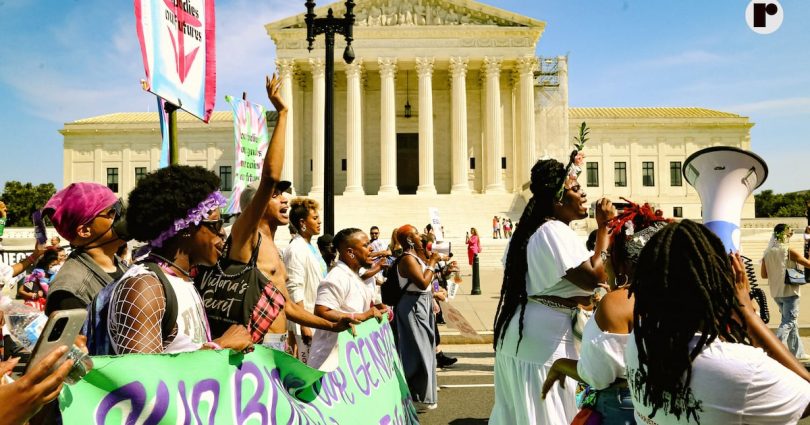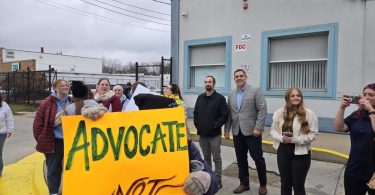
The late September heat bore down on hundreds gathered near Union Station in Washington, D.C., where the Gender Liberation Movement’s march brought together advocates fighting for both trans rights and reproductive justice. Among the speakers, Ash Orr stepped to the microphone with a story that challenged traditional movement boundaries: as a trans man from West Virginia who has had an abortion, his experience embodies the intersection of two increasingly threatened rights.
“When we look at what liberation looks like, it means honoring that trans, gender-nonconforming and intersex folks utilize abortion care, and that gender-affirming care includes access to abortion care,” Orr said. “If they can ban one thing, they could ban the other.”
The march, organized by GLM—a grassroots, volunteer-run national collective focusing on direct action, media, and policy interventions—represents a growing push to unite transgender and reproductive rights movements. The group’s core belief that these rights are inherently interlinked found powerful expression in Orr’s testimony.
As press relations manager for Advocates for Trans Equality, Orr has witnessed firsthand how the division between these movements plays out in policy discussions, even among supposed allies. In his home state of West Virginia, where legislators introduced 35 anti-trans bills this year, even LGBTQ-friendly politicians often shy away from connecting trans and reproductive healthcare.
“We can’t even get our elected officials to say trans people utilize abortion services,” Orr said, despite his efforts writing talking points and participating in countless advocacy calls.
His frustration points to a larger question facing both movements: “If you cannot say trans people need access to gender-affirming care, which includes abortion care, are you really an ally?”
This question has taken on new urgency as both movements face unprecedented challenges. Following former President Donald Trump’s win and a Republican-controlled Congress, Project 2025—a federal policy agenda for a conservative government administration—could reshape rights for women, trans and nonbinary people.
Despite reproductive rights and transgender rights both hinging on principles of bodily autonomy and self-determination, advocates question what stands in the way of their convergence amid a potentially greater uphill battle.
Following Trump’s win and a Republican-controlled House and Senate, Project 2025—a federal policy agenda for a conservative government administration could alter the course of rights for women, trans and nonbinary people. The 920-page blueprint, created by the Heritage Foundation and backed by more than 70 conservative organizations, outlines sweeping changes across federal agencies. Among its most aggressive proposals, the project calls for revoking federal protections for gender-affirming care, reversing FDA approval of medication abortion drugs, and mandating that all federal agencies define sex as “biological sex at birth.”
The project, which stems from deeply conservative Christian ideals, serves as a theocratic blueprint for the traditional family values, preaching anti-abortion and anti-trans initiatives. These include criminalizing the mailing of abortion pills, forcing states to disclose abortion-related data to the federal government, and enforcing traditional and heterosexual “biblically-based” marriages that are “social science-reinforced.”
Legal challenges mount
All eyes are on the Supreme Court as landmark cases on reproductive justice and trans rights hang in the balance. Though SCOTUS dismissed the Emergency Medical Treatment and Active Labor Act case (EMTALA) in June, the Ninth Circuit will hear arguments in December on whether Idaho’s near-total abortion ban conflicts with the federal requirement for emergency rooms to provide stabilizing care, including abortions.
The court case U.S. v. Skrmetti, could determine not only the constitutionality of banning gender-affirming care for trans youth under Tennessee’s SB1, but broader rights for transgender Americans. This case caps a year that saw unprecedented anti-trans bills, where out of 665 legislations introduced, 45 passed across 16 states affecting education, healthcare, sport participation, bathrooms and more.
According to the Movement Advancement Project’s nationwide map of bans on gender-affirming care for trans youth and the Center for Reproductive Rights’ map of abortion bans following Roe v. Wade’s overturning in 2022, the patterns overlap significantly; the South and Midwest face the most bans and restrictions on both abortion and gender-affirming care.
Both movements could benefit from unifying as one—but not without reconciling their respective differences that kept them separate.
Race and access
Restrictions on reproductive and trans rights disproportionately affect Black communities. According to the Pew Research Center, more than half of Black Americans living in the U.S. reside in the South.
“There’s a huge overlap between where there are heavy abortion bans, where there is anti-trans legislation, and where there are like a bunch of Black people,” said Louise. “So all of this is very intentional, very targeted in further marginalizing already estranged communities.”
According to the National Partnership for Women and Families, 57% of Black women of reproductive age live in states with abortion bans, 2.7 million of which experience financial insecurity. Similarly, the National LGBTQ Task Force reports that 34% of Black trans people report an annual household income of less than $10,000.
Despite Black people being most heavily impacted by legal restrictions to bodily autonomy, Britni Louise, organizing and outreach manager at ARC Southeast, says that white cisgender women have the most visibility in the abortion rights movement, particularly at the national level.
“I do think that one of the biggest barriers that we encounter is the idea that abortion access and reproductive justice is just a cis women’s movement, and I think more broadly, a lot of pro-Black, national formations are very like cis centered,” Louise said.
Louise points to the role of trans exclusionary radical feminists, or TERFS, who advocate for feminism that shuns trans individuals. According to a 2019 Vox article, this type of gender-critical feminism argues that under the patriarchy, people born with vaginas are oppressed and views people born with penises as oppressors, including trans women and gender non-conforming individuals.
“When people think about feminists, these are the people who come to mind and they’re saying you know, ‘women’s rights’, talking about women, talking about motherhood, talking about parenting inside of the context of a cis woman experience,” said Louise.
Movement origins and funding
The structure of reproductive justice is inclusive and originated as a movement in response to the abortion rights movement, which did not encompass diverse identities and the complex roles that race, social class, environment and more play in bodily autonomy. As defined by SisterSong, a national activist organization dedicated to reproductive justice for people of color, reproductive justice is the human right to maintain personal bodily autonomy, have children, not have children, and parent children in safe and sustainable communities.
“Independent grassroots organizations, independent abortion funds, have to work through so much cis-hetero propaganda that’s being propagated by larger national orgs who are catering to cis white women,” said Louise.
Kierra Johnson, president of the National LGBTQ Task Force, said that in the nonprofit world, organizations often get “tunnel vision,” which may contribute to the lack of collaboration between movements, adding that funders historically haven’t awarded intersectional funding.
“How many LGBTQ groups do you know that get support for doing abortion rights work or sex ed work? Or how many women’s organizations or reproductive health and rights organizations get funding for broadening and creating a more gender expansive right movement, right?” Johnson said. “It’s almost like, of course, do the right thing because you should do the right thing, but it’s not like there’s a lot of funding happening at those intersections.”
While the challenges are significant, some organizations are creating blueprints for successful collaboration. The Reproductive Freedom Fund of New Hampshire’s Queer Care Fund, launched in partnership with 603 Equality, demonstrates how abortion funds can expand their mission to support trans healthcare. Since January, they’ve provided $10,000 to independent health clinics offering gender-affirming care and helped more than 50 trans patients access services ranging from appointment costs to transportation.
The Kentucky Health Justice Network offers another model, establishing a trans health advocacy program alongside its abortion services. These collaborations often emerge naturally, building on existing relationships with healthcare providers who offer both abortion and gender-affirming care. According to a 2017 Guttmacher Institute study, 23% of abortion providers, including independent clinics and Planned Parenthood locations, also provide gender-affirming care—meaning clinic closures due to anti-abortion laws directly impact trans healthcare access.
The overlap: Trans people who need access to both
Beyond abortion bans, transmasculine individuals face additional burdens when seeking reproductive healthcare and abortion—particularly transphobia and a lack of trans literacy in healthcare. A 2021 Ibis Reproductive Health Report found that transphobia led medical staff to misgender patients or refuse to provide care, and they lacked overall knowledge about transgender bodies and health.
According to Johnson, this gap between reproductive and transgender movements can be attributed to a “nonprofit culture,” in which organizations formed because people knew work needed to be done, and money and infrastructure were easy methods of organizing. The distinction between the two, Johnson explains, allowed for easier funneling of funds.
The root historical differences between the two led both movements on separate trajectories, which Johnson says provides perspectives on today’s separation. Now, as the overlap grows, the demand for inclusion on all fronts is louder.
Orr said the easiest step towards joining the movements is using inclusive language, presenting reproductive rights as not just a woman’s issue and acknowledging that trans people are involved in the movement for trans liberation. Orr says that cisgender abortion activists need to advocate for trans liberation as well.
“As allies, we don’t want folks to speak on behalf of us, but we want folks to speak up for us,” he said.
Activists say fear plays a major role in the legislative attacks on human rights. In Louise’s words: fear turns into stigma, and stigma becomes criminalization targeting people who have abortions and trans people.
“The same pool of people that are saying ‘they’re doing post-birth abortions,’ those same lies are the same lies that are like ‘they’re giving kids sex reassignment surgery,’” said Louise.
Louise said fear contributes to the criminalization of both groups, and tackling the fear of trans people and people having abortions may be key to progressing both movements.
“Trans people are not scary. Abortion is not scary,” she said. “If we’re going to be able to advocate for ourselves and our communities and make it through the next four [years], the next eight, like make it through this next political moment and beyond that, we have to be able to stand up with each other and stand up against oppressive forces.”
Looking ahead to another Republican presidential term alongside a Republican-controlled Congress, the future for both movements remains unpredictable—potentially harder than before. Johnson, however, offers one truth worth holding onto.
“We’ve got ancestral knowledge. We’ve got tribal knowledge. We’ve got elders who know how to help us out. We got this.”







